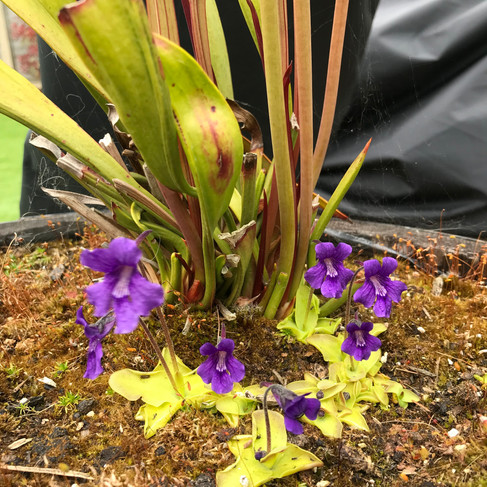A picture of same group of plants every week until fully out of dormancy and regrown.
It’s finally Spring once again! The return of sunny and longer days means the plants are starting to wake up from their winter dormancy. For me, this is my favourite time of year because after several months of little going on, it all suddenly comes back in one wonderful flow. The cold dark winter does feel like it goes on forever but it also builds up a lot of excitement for me as when you finally see that first Sarracenia flower bud or first new dewy leaf on your Drosera you know that wait has paid off and the growing season is almost here.
For first time growers or those who have experienced dormancy for the first time it can sometimes be daunting to see whether your plants made it through the winter. If you have overwintered your plants outside or in an unheated greenhouse or similar then plants will begin to start growing again around March time, this can differ based on where you are.
Usually there is nothing to worry about and you get to see how hardy these plants truly are. This winter especially we have had a bitterly cold and drier winter, with the lowest for me getting down to -7 degrees but I haven’t had any major losses and all the plants are starting to come back out the other end.
Check out my Blog 'How to Care for Carnivorous Plants During Dormancy' for more information on what dormancy is, what plants need it and how to care for them. This is also a good comparison to see what plants look like at the start and the end of the winter period.
This is also that time of year my camera and macro lens come out once again to capture every new leaf and new flower so with all these thousands of images it helps me document and show the growth of the plants at every step. So this blog allows me to put those images to use!
What plants look like that the end of their Dormancy period:
Sarracenia
The first signs of growth with Sarracenia are usually the flower stalks, these appear at the center of the growing point of the plants, starting off as a ball shape which grows on top of a stem. The flowers can grow really tall and will start to curve at the top before the flower begins to open. Younger plants will not produce flower stalks until mature so this will depend on how mature your plant is.
(Left) Sarracenia 'Lynda Butt' with flowers emerging from multiple rhizomes. (Right) Sarracenia flowers on multiple plants in the greenhouse.
(Left) Three Sarracenia flava flowers from the same plant at different stages of opening. (Right) Multiple Sarracenia flowers at various stages
When the first new pitchers on your Sarracenia begin to form, they will often look like flat or slightly rounded stems with a hood. These will either follow after flowers begin to form or will grow naturally when the weather warms up, Sarracenia flava often is the first species to put out new pitchers.
(Left) Sarracenia 'Asbo' first new pitcher. (Right) Multiple Sarracenia seedlings getting their first new pitchers of the season
Sarracenia flava 'A Slack Maxima' pitchers at different stages of opening
Dionaea
Flytraps will begin to produce several new leaves as the weather warms up, these leaves may be more upright leaves than the winter ones. The traps will often gain more colour as they mature once opened, especially on all red varieties
(Left) Dionaea muscipula 'Red Piranha' before getting new growth. (Right) First new traps on the same plant
Flower stalks will often soon follow, these are long spikes with a ball on top which emerge from the center of the plant. If your plant is not looking healthy then I recommend cutting the flower stalk off before it flowers as these flowers take a lot of energy from the plant. You can snip the stalk off when it is a few inches tall then cut into inch sized pieces and place them vertically in your media in order to grow new plants. If you wish to get seed from your plants and they are healthy then you can let your plants flower, make sure to pollinate the flowers by hand in order to get the seed.
(Left) Flower stalks on multiple plants. (Right) flower stalk on B52
Darlingtonia
Similar to Sarracenia, Darlingtonia will begin the season by producing flower stalks, if mature enough. The stems of which are often pink in colour. Flowers can be kept and pollinated by hand in order to get seeds.
Pitchers are strange looking things, a little bit like baby snakes, they are often wide with a little tongue which will develop as it grows.
(Left to right) Darlingtonia flower when open, Darlingtonia new pitchers, Darlingtonia with it's flower
Temperate Drosera
This includes all your Drosera which produce hibernacula and die down the roots at the end of the year such as D. filiformis, D. intermedia and D. rotundifolia which will start by unfurling their leaves from the tight winter resting bud, you will often start to see a looser bud after several sunny days in Spring.
My Drosera filiformis at different stages from waking up from it's hibernacula in Spring.
Other Drosera such as Drosera binata which will often die down to the roots in winter if kept in an unheated greenhouse will start to show new growth often red in colour before turning green and starting to unfurl curled leaves.
My Drosera binata var dichotoma at different stages of waking up
Even Drosera which do not need a winter dormancy but are hardy enough to tolerate the cold, such as Drosera capensis, can also be kept in an unheated greenhouse or outside year round. These plants will die back down completely and start to come back in Spring, they are often the first things to come back in my greenhouse along with Sarracenia flowers and regrow very quickly!
Drosera capensis 'alba' at different stages of waking up
Sometimes you may feel like your plants have died over winter but it is important to keep them aside a little longer before throwing them out just incase. Even the plants that look the worst can come back!
For example Drosera aliciae looks very upset during the winter and will sometimes go completely brown but after a couple of months in Spring it is surprising the come back it can make.
(Left) Drosera aliciae starting to come back after winter. (Right) The same plant a month later after fully regrowing
Temperate Pinguicula
Similar to the Drosera, the Temperate Pinguicula have a hibernaculum. They will start to loosen their winter resting bud and begin to produce new leaves in Spring. After they have produced a couple of leaves the plants will be begin to flower.
(Left to right) Pinguicula 'eye spy' starting to come back from it's bud, the same plant more open and the P. grandiflora fully open.
The flowers from Pinguicula are particularly showy and beautiful, they add a little touch of colour at the beginning of the year especially in an outside bog or container.
Pinguicula grandiflora flowers!







































































